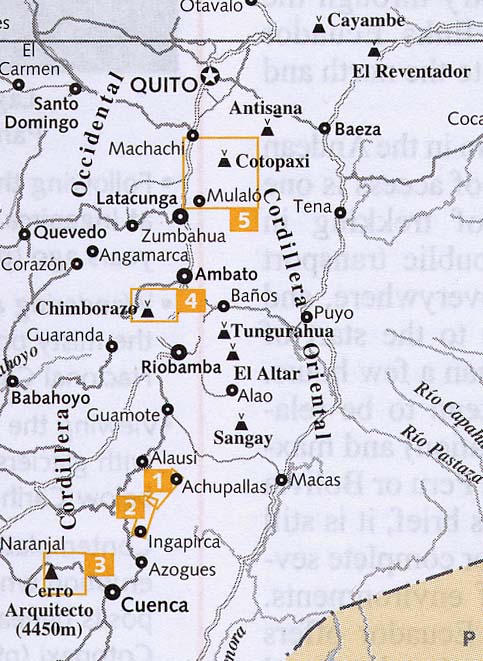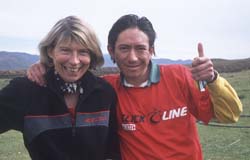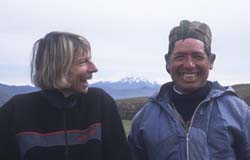Informations
A FEW PRACTICAL INFORMATIONS
(Ecuador - November 2005)
|
Practical
Informations |
|
Two parallel ranges of volcanoes run N-S through Ecuador (they are sometimes incorrectly called Cordilleras, which they are not). Between the two ranges, the Sierra, a high plateau, where are located most of the larger towns. |
 |
A few books :
The base:
- Lonely Planet: "Trekking in the Central Andes" - 2nd edition - June 2003
- Guide du Routard "Equateur - 2004/2005" (in French)
Trekking and climbing guides :
- "Ecuador, a climbing guide ", by Yossi Brain (Cordee 2000) : the ascent routes of all the mountains in Ecuador are described in details. The book also includes very interesting general chapters relating the climbing history, as well as practical information about the country.
- "Trekking and climbing in the Andes ", Val Pitkethly & Kate Harper (Stackpole Books 2002) : 26 treks in the Andes are described in details, including pictures. Among those, 4 treks in Ecuador.
- And, of course, if you find it, and if you can afford the price, there is Whymper's book : "Travels amongst the great Andes of the Equator" (John Murray 1892). After the tragedy of the first ascent of the Matterhorn, and the controversy which followed (was the rope cut on purpose ?), Whymper decided to make himself scarce in the Alps, but of course he still wanted to climb mountains... He then got the idea of studying the influence of high altitude on men. Himalaya not being accessible at that time, for political reasons, he decided to explore Ecuador, which was then quite unkown, and where there are some very high mountains. His trip lasted about six months (end 1879 to mid 1880), during which he systematically climbed all important summits in Ecuador, often for the first time. His objectives being mostly scientific (?), he collected a great number of data on the fauna, flora, geology and altitudes of the mountains he climbed. Reading his notes is sometimes a bit boring for the non-specialist, but one does not have to read it all, and the fact remains that this trip was quite extraordinary.
The expenses :
We went from France to Quito via Madrid, so as to travel all the way with the same company (Iberia), and in order to simplify possible luggage problems (we had a problem on the way back - which was then without consequence).
Hotel in Quito (two nights on arrival, and one night before leaving) : Hotel Posada del Maple. 28 $ for a double room, breakfast included. Friendly and clean. Excellent. A visit to the old Quito is mandatory - and anyway one has to start to acclimatize.
Hotel in Latacunga (which was our base) : Hotel Tilipulo (hoteltilipulo@hotmail.com), on Calle Guyaquil, in the center. 18 $ for a double room, breakfast not included. Friendly and clean, but the rooms with windows on the street may be very noisy, particularly on a saturday night...
Public tranport is very cheap (1,5 $ from Quito to Latacunga...) but very efficient and frequent.
Excellent restaurants at reasonable prices (around 5 $ per person). Grilled meat is excellent. Wine is expensive, as it is not produced in Ecuador, but the beer is good.
Trekking/mountaineering agency : for several reasons, we could not plan our trip beforehand. We then improvised on the spot, choosing a base close to the mountains : Latacunga. The Tovar agency (Fernando Tovar - tovarexpeditions@hotmail.com) is located close to the Tilipulo Hotel (corner Guyaquil-Quito), and provided us a perfect service : the owner, Fernando Tovar, is a very competent and very attractive mountain guide, who has guided clients up many mountains in South America (Argentina and Peru as well as Ecuador), perfect guide and "arriero", fantastic food, total flexibility to adapt to our requests... and perfectly on time on all our meetings !
We decided to acclimatize by trekking with a guide and a pack horse for several reasons : we did not want to carry on our backs the supplies necessary for a long trek, the maps are not very accurate (and there are no trails), and, lastly, trekking is an excellent opportunity to get acquainted with local people - and we were very much rewarded !
The cost of the trek was 60 $ per person per day (everything included : transport, entry to the Park, food, pack horse, equipment, etc...). During the ascents, we were only accompanied by Israël, who carried the food. 140 $ per person per day, including all expenses (transport, entry to the Park, hut fee, mountaineering equipment, etc...). This is not very cheap, but the service is well worth it - and, in the end, we contributed directly to the local economy...
Our guide, Israël Paez. |
 |
 |
Oswaldo, our "arriero". He took care of us like a father ! |
What to take along :
- Not being certain to find quality equipment locally, we carried our high-altitude tent. But we could have dispensed with it : the agency has excellent tents (it should be resistant to the weather, and particularly to the frequent and strong rain and hail storms). Before the ascents, we slept in the huts (we were lucky, as they were almost empty)
- Sleeping bag (to be taken also in the huts) + mat (the agency may provide one).
- Warm Gore-Tex rain-resistant clothing : the trek is mostly at an altitude of 3800 to 4000 m, the temperature is often low, and storms are frequent
- Good trekking shoes (Gore-Tex).
- We took along our own mountaineering shoes and crampons, but the agency has some on loan. We borrowed ice picks and harness from them. Of course, the guide had his own rope.
- One (or several) cameras !
It is of course strongly suggested to wrap the contents of the pack in tight Ziploc plastic bags...